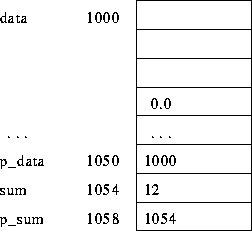double data[10];
double *p_data;
int sum;
int *p_sum;
p_data = data;
p_data[3] = 0.0;
p_sum = ∑
sum = 10;
printf("Sum: %d\n", p_sum);
*p_sum = 12; /* Dereference the pointer */;

- You can never add two pointers, but you can add a pointer and an
integer:
double sum; double data[10]; double *dp; int i; sum = 0.0; for (i = 0, dp = data; i < 10; i++, dp++) sum += *dp;
Note thatdpwill be incremented bysizeof(double). -
data[4]is another way of writing*(data + 4). - You can subtract two pointers:
int strlen(char *s) { char *ptr = s; while (*ptr != '\0') ptr++; return ptr - s; }